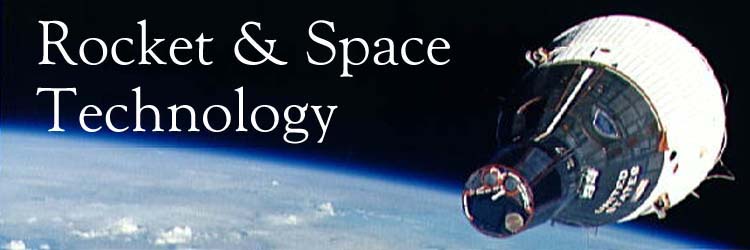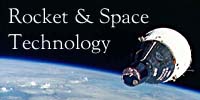 |
|
Please also try these Recommended Web Sites      Have a question or comment? Please email me at webmaster@braeunig.us (Also try the Forum) Web Counter says you are visitor Selected by the SciLinks program, a service of the National Science Teachers Association, copyright 2001  Rocket & Space Technology is proud to have been presented the following awards for excellence      |
Welcome to Rocket and Space Technology. This Web page can
trace its roots to the author's project to write a computer program
simulating the launch of a rocket to orbit. As I performed my research
it became apparent that most information on the subject tended toward
one of two extremes: it was either too simplistic to be very helpful,
or it was advanced texts written for engineers. I could find little
information suitable for the space enthusiast who wanted to progress
beyond the beginner level but who lacked the advanced math and science
skills needed to understand the more complex texts.
After spending months digging through books and Internet sites I
finally found the information needed to complete my project. Not
wanting others to go through the same frustrating search, I decided to
organize all the information into a single resource. Thus, in 1996 this
Web page was created.
Most of the information from my original research can be found in the Basics of Space Flight section. Through the years additional information and sections have been added, such as my debunking of the absurd moon landing hoax theory.
It is my hope this site continues to grow and improve. Please enjoy
your visit and learn a little about the fascinating science of space
flight.
Robert A. Braeunig
This page is the launching pad to propel you on your visit through Rocket and Space Technology.
You can visit any page by clicking on the section titles in the Table
of Contents to the right or by clicking on any of the highlighted
links. If you entered this site through the main index page will see a
navigation bar across the bottom of this window. This bar includes
links to all the major sections of this Web site. Alternatively, you
can use the drop-down menu at the bottom of each page. Clicking "Home",
either on the navigation bar or at the bottom of a page, will return
you to this home page. If the navigation bar is not visible, try
clicking Navigation Bar now to activate.
The Basics of Space Flight section is a tutorial designed to teach the basic science behind rocketry and space flight. Part I, Rocket Propellants, compares the properties of the various fuels and oxidizers used in rocketry. Part II, Rocket Propulsion, explains how rockets work and examines how engines convert chemical energy into thrust. Part III, Orbital Mechanics, discusses how space vehicles move under the influence of forces such as gravity, thrust, and drag. Part IV, Interplanetary Flight, studies the trajectories used to travel between planets.
This section is not for those with an aversion to mathematics
as we focus largely on problem solving. Although some derivations use
calculus, application of the derived formulae requires no more than an
understanding of algebra and trigonometry. Each section includes
example problems to demonstrate the use of the formulae.
I have personally authored only a small part of the text
contained in Basics of Space Flight. The information was mostly
assembled piecemeal from a variety of sources. I hope you find the
final product a useful and well-organized compilation. All sources have
been credited in my Bibliography page.
The
Space Hardware section describes many space vehicles and launchers. Part I, Spacecraft Systems, defines the most common types of spacecraft and describes their primary subsystems. Part II, Launcher & Spacecraft Specifications,
provides detailed technical data and description of most manned
spacecraft, space stations, selected launchers, and engines. Part III, Space Launch Vehicles, is a list of the world's launch vehicles, both past and present (although currently not up to date).
The
Space Missions section provides comprehensive lists of all major manned and robotic space flights. Part I, Manned Space Flights, includes all piloted manned missions by all nations. Part II, Planetary Spacecraft, includes most interplanetary space probes and landers. Part III, Lunar Spacecraft,
includes most unmanned probes and landers sent to the Moon. These
lists include not only the successful missions but the many failed
attempts as well.
Satellites such as Sputnik and Explorer I, and observatories
such as the Hubble Space Telescope, although historically and
scientifically important, are not included because they do not fall into
any of the three classifications described above.
In this section we provide a description of the work performed at each of the World's Space Centers.
Included are both launch facilities and research & development
centers. Also provided are a list of the number of orbital launches by
site, complete through 1995, and a map showing the location of each
launch center.
Since adding this section in 2001 it has grown to become this
site's most frequently visited page. I am happy about the page's
popularity but I regret it is even necessary. Did We Land On the Moon?
examines point-by-point the conspiracy claims that NASA faked the
Apollo moon landings of 1969-72. I think you will agree the claims are
nothing more than pseudoscience nonsense.
This site also includes a chronology of important Rocket & Space Milestones, a Glossary of many rocketry and space-related terms, a WWW Space Links page providing a list of recommended Web sites, and an Bibliography
page where I give credit to all sources, both printed and Internet,
used in the creation of this Web site. Finally, there is a Memorial page in which I pay tribute to the brave astronauts and cosmonauts who gave their lives in the quest to explore space.
The
Discussion Forum, provided courtesy of The Space Race,
is a good place to talk about space science and technology. You can
ask questions and learn about rockets, space exploration, or any other
related topic; or you can share your knowledge and help others. If you
wish to engage in a discussion about any of the items found in this Web
site, I recommend you visit the forum. Although I am happy to
correspond via email, the forum will allow more people to contribute to the discussion.
 This
photograph is a view of the Gemini 7 spacecraft taken from the hatch
window of Gemini 6 during rendezvous and station keeping maneuvers at an
altitude of approximately 160 miles on December 15, 1965 (NASA Photo ID
S65-63188). This photo was chosen for this Web site's logo because of
the historical and technological significance of the joint Gemini 6-7
mission (plus it's just a really cool photo). This mission achieved the
first rendezvous of two spacecraft. It was a critical milestone that
without which a landing on the moon would have been impossible. This
mission and the Gemini flights that followed taught Americans how to
maneuver and work in space. This
photograph is a view of the Gemini 7 spacecraft taken from the hatch
window of Gemini 6 during rendezvous and station keeping maneuvers at an
altitude of approximately 160 miles on December 15, 1965 (NASA Photo ID
S65-63188). This photo was chosen for this Web site's logo because of
the historical and technological significance of the joint Gemini 6-7
mission (plus it's just a really cool photo). This mission achieved the
first rendezvous of two spacecraft. It was a critical milestone that
without which a landing on the moon would have been impossible. This
mission and the Gemini flights that followed taught Americans how to
maneuver and work in space.
November-2013: Added "Gravitational Assist" to the Interplanetary Flight section.
November-2012: Added the appendix Rocket Thermodynamics.
May-2012: Added the page Interplanetary Flight and appendices Vector Mechanics and Planet Positions.
February-2012: Revised the Orbital Mechanics section. Added "The Hyperbolic Orbit" and added material to "Launch of a Space Vehicle."
August-2009: Added design information about nozzle shapes and combustion chambers to the Rocket Propulsion section.
June-2007: Reorganized and renumbered the Basics of Space Flight section. Added new material to the Rocket Propulsion and Orbital Mechanics sections.
August-2006: Added the page Rocket & Space Milestones.
October-2005: Made additions to the Rocket Propulsion section. Added Propellant Combustion Charts. Updated Atlas and Delta launch vehicles.
January-2005: Made extensive revisions and additions to the Orbital Mechanics section. Converted all example problems to the SI System of units.
August-2004: The entire Web
site was given a major makeover. The home page was redesigned, several
pages were consolidated, and site navigation was improved. Link to the
discussion forum was added.
http://www.braeunig.us/space/index.htm
Penulis : Drs.Simon Arnold Julian Jacob
|
Tidak ada komentar:
Posting Komentar
ORANMG PINTAR UNTUK TAMBAH PENGETAHUAN PASTI BACA BLOG 'ROTE PINTAR'. TERNYATA 15 NEGARA ASING JUGA SENANG MEMBACA BLOG 'ROTE PINTAR' TERIMA KASIG KEPADA SEMUA PEMBACA BLOG 'ROTE PINTAR' DIMANA SAJA, KAPAN SAJA DAN OLEG SIAPA SAJA. NAMUN SAYA MOHON MAAF KARENA DALAM BEBERAPA HALAMAN DARI TIAP JUDUL TERDAPAT SAMBUNGAN KATA YANG KURANG SEMPURNA PADA SISI PALING KANAN DARI SETIAP HALAM TIDAK BERSAMBUNG BAIK SUKU KATANYA, OLEH KARENA ADA TERDAPAT EROR DI KOMPUTER SAAT MEMASUKKAN DATANYA KE BLOG SEHINGGA SEDIKIT TERGANGGU, DAN SAYA SENDIRI BELUM BISA MENGATASI EROR TERSEBUT, SEHINGGA PARA PEMBACA HARAP MAKLUM, NAMUN DIHARAPKAN BISA DAPAT MEMAHAMI PENGERTIANNYA SECARA UTUH. SEKALI LAGI MOHON MAAF DAN TERIMA KASIH BUAT SEMUA PEMBACA BLOG ROTE PINTAR, KIRANYA DATA-DATA BARU TERUS MENAMBAH ISI BLOG ROTE PINTAR SELANJUTNYA. DARI SAYA : Drs.Simon Arnold Julian Jacob-- Alamat : Jln.Jambon I/414J- Rt.10 - Rw.03 - KRICAK - JATIMULYO - JOGJAKARTA--INDONESIA-- HP.082135680644 - Email : saj_jacob1940@yahoo.co.id.com BLOG ROTE PINTAR : sajjacob.blogspot.com TERIMA KASIH BUAT SEMUA.